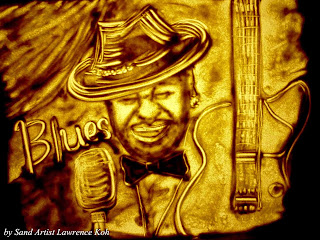"In Buddhism, they say attachment to anything only leads to suffering. So when we laugh, it's our way of saying, 'I'm unattached to that.' You're tickled by it, it makes your lobes do something on their own. So humor is very important to me. I always take that to the stage first." - Jason Mraz
Sand animation, also known as sand art, is a term which has two meanings. It is the name given to a style of live performance art and to a type of animation. In the former, an artist creates a series of images using sand, a process which is achieved by applying sand to a surface and then rendering images by drawing lines and figures in the sand with one's hands. A sand animation performer will often use the aid of an overhead projector or lightbox (similar to one used by photographers to view translucent films). In the latter, animators move around sand on a backlighted or frontlighted piece of glass to create each frame for their animated films.
Sand Painting of the World:
Tibet - The Sand Mandala (Tibetan: དཀྱིལ་འཁོར།, Wylie: dkyil 'khor; Chinese: 沙坛城; pinyin: Shā Tánchéng) is a Tibetan Buddhist tradition involving the creation and destruction of mandalas made from colored sand. A sand mandala is ritualistically dismantled once it has been completed and its accompanying ceremonies and viewing are finished to symbolize the Buddhist doctrinal belief in the transitory nature of material life.
Native American - In the sandpainting of southwestern Native Americans (the most famous of which are the Navajo (known as the Diné)), the Medicine Man (or Hatałii) paints loosely upon the ground of a hogan, where the ceremony takes place, or on a buckskin or cloth tarpaulin, by letting the coloured sands flow through his fingers with control and skill. There are 600 to 1,000 different traditional designs for sandpaintings known to the Navajo. They do not view the paintings as static objects, but as spiritual, living beings to be treated with great respect. More than 30 different sandpaintings may be associated with one ceremony.
Indigenous Australian - Indigenous Australian art has a history which covers more than 30,000 years, and a wide range of native traditions and styles. These have been studied in recent decades and their complexity has gained increased international recognition.[2] Aboriginal Art covers a wide variety of media, including sandpainting, painting on leaves, wood carving, rock carving, sculpture, and ceremonial clothing, as well as artistic embellishments found on weaponry and also tools. Art is one of the key rituals of Aboriginal culture. It was and still is, used to mark territory, record history, and tell stories about "The Dreaming".
Japanese tray pictures - From the 15th century in Japan, Buddhist artists in the times of the shoguns practiced the craft of bonseki by sprinkling dry colored sand and pebbles onto the surface of plain black lacquered trays. They used bird feathers as brushes to form the sandy surface into seascapes and landscapes. These tray pictures were used in religious ceremonies. Japanese esoteric Buddhism was transmitted from East Central Asia after the 8th century, and thus these Japanese Buddhist sandpaintings may share earlier historical roots with the more intricate brightly coloured Buddhist sand mandalas created by Tibetan Buddhist monks.
Table decking - During the 17th and 18th centuries, the royal courts of Europe employed "table deckers", who decorated the side tables at royal banquets having adapted the craft of 'bonseki' from the Japanese. The table deckers sprinkled coloured sands, marble dust, sugars, etc. upon the surface of plain white tablecloths to create unfixed pictures of fruit, flowers, birds and rustic scenery. In between each design spaces were left for fruit bowls and sweetmeat dishes so that the diners could refresh themselves in between the main courses of the feast. These ornate pictures were discarded along with the debris of the feast.
Georgian sandpainting - Sandpainting as a craft was inspired by King George III, who was a skilled watchmaker and craftsman in his own right, and took an interest in the skills demonstrated by royal functionaries, known as Table Deckers, who decorated the white table-cloths at royal banquets with ornate centre-pieces decorated by using coloured sands and sugars as 'paint', and a bird's feather as a 'brush' a craft introduced by a European traveller who had observed the craftsmen at work in Japan.
Victorian sand picture souvenirs - Thousands of sites exist where it is possible to collect natural coloured sands for craftwork, with an enormous range of colours being available around the globe varying with the contents of the mineral charged waters leaching through the sands. But for the tourist the vertical sand cliffs at Alum Bay on the Isle of Wight form the central portion of a visual geological phenomenon (best viewed after a shower of rain) which encapsulates the impressive chalk spires of The Needles and Tennyson Downs. Aspiring sand crafters are now banned from risking their lives climbing the cliffs to collect the 21 coloured sands available in the bay, and to prevent excessive damage to the environment, but the sand kiosks have in the past been there to supply their needs.
Senegal - In the 1860s to 1890s Andrew Clemens a deaf mute born in Dubuque, Iowa, USA became famous for his craft of creating unfixed pictures using multicoloured sands compressed inside glass bottles or ornate chemist jars. The sand was collected from the bluffs overlooking the Mississippi. The subjects of his sand bottles included ornately decorated sentimental verses, sailing ships, plants, animals and portraits.
—





















